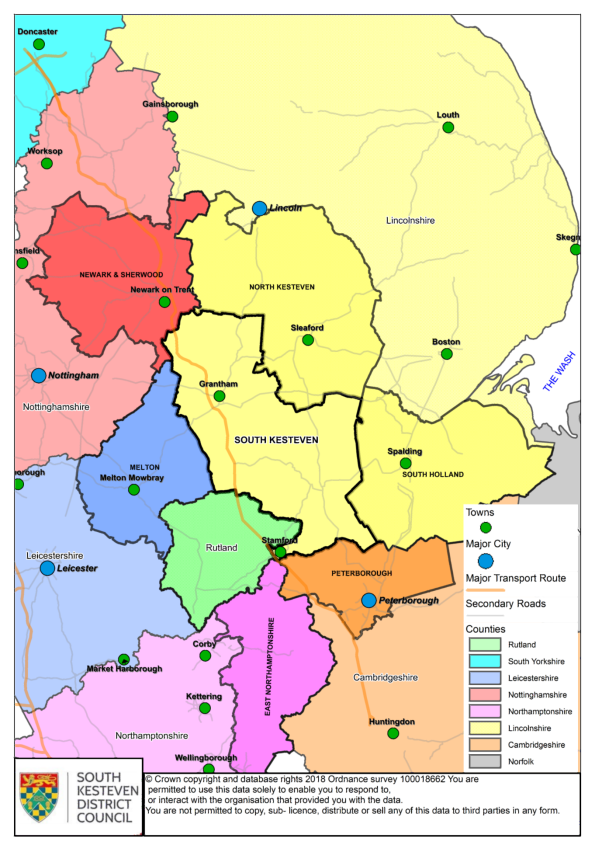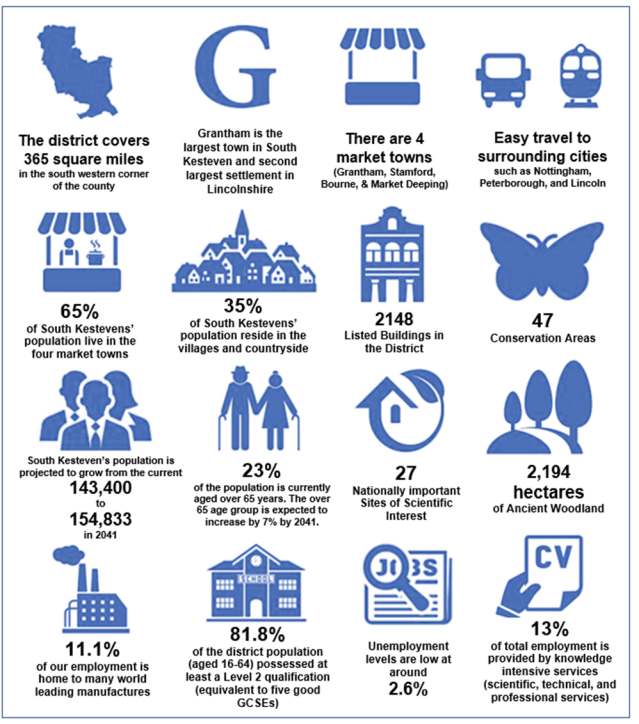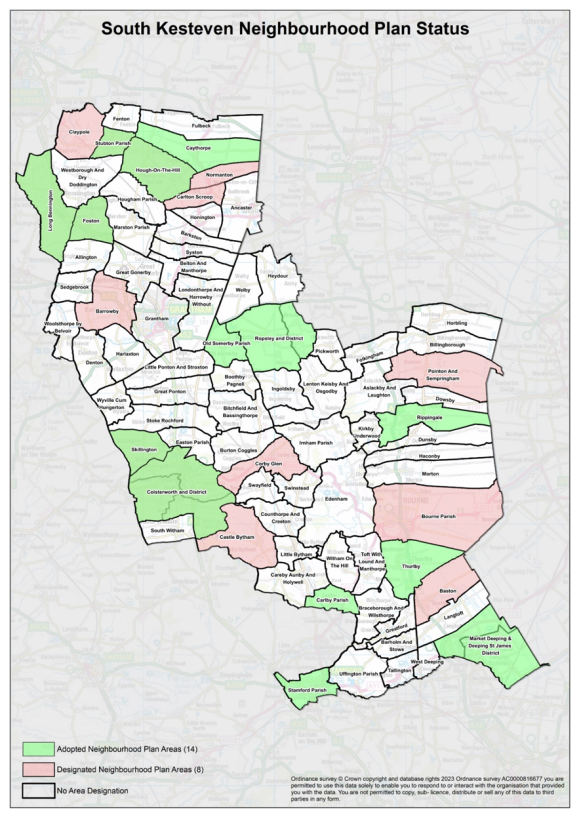Regulation 18 Draft Local Plan
(8) Chapter 2 - South Kesteven District
(8) Plan period
2.1 The Plan period will run from 1st April 2021 through to 1st April 2041. The Local Plan is forward thinking; the NPPF states that Local Plans should preferably plan for a 15 year time horizon.
2.2 The Plan Period up to 2041 provides an additional five years beyond the current plan period of the adopted Local Plan which runs to 2036.
2.3 A glossary of terms used in this document is set out in Appendix 3.
(6) Climate Change
2.4 South Kesteven District Council declared a climate emergency in 2019 and recognises the need for urgent action on climate change. The Council published a Climate Action Strategy in 2023 setting out how we can respond to the global issue of climate at a local level.
2.5 The challenges presented by climate change are twofold: one in contributing to the UK government's targets to rapidly reduce carbon emissions to meet net zero emissions by 2050; and secondly in the need to adapt to increasing impacts of extreme weather and living in a warmer world.
2.6 The NPPF states that the planning system should help to shape places in ways that contribute to radical reductions in carbon emissions, minimise vulnerability and improve resilience, encourage the reuse of existing resources and support renewable and low carbon energy and associated infrastructure.
(12) Housing Growth
2.7 As required by the NPPF, the Local Plan must define overall levels of growth for new housing across the District. These growth levels are to be informed by evidence of assessed need in the case of housing provision.
2.8 This Regulation 18 consultation calculates housing need using the government's standard method. The minimum Local Plan requirement for South Kesteven is 14,020 dwellings across the plan period 2021 – 2041, equating to 701 dwellings per annum. Whilst the housing need is based on the standard methodology, the supply will also contain an oversupply of around 20% above the minimum required to ensure the Council delivers at least the minimum Local Plan requirement of 14,020.
(11) Employment Growth and Prosperity
2.9 The NPPF makes it clear that Local Plansshould help create the conditions in which businesses can invest, expand, and adapt, with significant weight being placed on the need to support economic growth and productivity. Local Plans should also seek toidentify strategic sites, for local and inward investment to match the strategy and to meet anticipated needs over the plan period.
2.10 South Kesteven District Council has an ambitious vision for the sustainable growth of the District; a vision which will not be achieved by the Council alone, but which will rely on it working alongside other public sector bodies and the private sector.
2.11 South Kesteven is home to some world-leading businesses but has significant untapped potential - offering an exciting opportunity for investment, bringing economic growth and prosperity, both to the District and the wider area beyond. The latest job figures from the Office of National Statistics, present a density of 0.83 which means that there is 0.83 jobs for every resident aged 16-64.
2.12 The Employment Land Study 2023 indicates that the employment land requirement for the district up to 2041 is 79.5 hectares based on labour market demand statistics.
2.13 The Local Plan aims to help meet the objectives of the Council's Economic Development Strategy and the identified employment land requirement. It seeks to ensure that there is sufficient land available in the right locations to support a strong and growing local economy in the District. A new Economic Development Strategy is underway.
2.14 The draft Local Plan recognises the strategic significance of key employment sites and includes a supply of employment land up until 2041, including draft allocations.
2.15 Additional policies are proposed to support the expansion of existing businesses and to protect existing employment sites, as well as restricting the loss of employment land and buildings to non-employment uses.
2.16 The Local Plan also includes a policy which seeks to support the further development of the visitor economy in recognition of the important contribution this makes to the District.
(6) Planning for Population Changes
2.17 The District of South Kesteven is projected to grow from a population of 143,400 in 2021 to 154,833 in 2041. Alongside this, the age profile of the District will also change significantly through a growing older population.
2.18 Our aim is for the majority of all planned housing development to be focused upon growing Grantham in order to support and indeed strengthen its role as a Sub-Regional Centre. Given their role as market towns with a range of services and facilities, the Local Plan also proposes new development in Stamford, Bourne and the Deepings.
2.19 A review of the Larger Villages has been undertaken and land identified to meet identified need. In addition to these allocations, the Local plan supports sensitive infill housing development within the built-up part of settlements and the redevelopment of previously developed sites in all fifteen Larger Villages. Whilst smaller villages are not deemed sustainable locations for site allocations, the Local plan supports sensitive housing development within the built-up part of the settlements and the redevelopment of previously developed sites.
2.20 Some small scale sensitive development on the edge of all settlements, defined in Policy SP2, will also be supported subject to more restrictive criteria, including evidence of substantial support from the local community. Development outside of settlements will be restricted to essential development in order to support the rural economy.
(6) Meeting Specific Housing Needs
2.21 In line with the 2023 Local Housing Needs Assessment, the Local Plan includes policies to support affordable housing and on certain sites make plots available for custom or self-build.
2.22 The Council will encourage an appropriate mix and form of housing to meet the needs of current and future households across the District.
2.23 The Council has commissioned a Gypsies, Travellers and Travelling Showpeople Accommodation Needs Assessment and will seek to meet the needs of our community through the identification of land, if required.
(8) Protecting and Enhancing the Environment
2.24 We have a rich built and natural environment in South Kesteven. The policies of the Local Plan aim to protect and enhance the character of the District.
2.25 The Local plan includes policies for protecting landscape and biodiversity and the requirement for developments to demonstrate biodiversity net gain, pollution control, water environment and Flood Risk Management, and the historic environment. In addition, the Local plan seeks to promote good quality design in all new developments – this has been enhanced through the production of a Design Guide Supplementary Planning Document to encourage high quality design. A new district wide Design Code is currently being prepared in accordance with the National Design Guide.
2.26 An Open Space, Sports & Recreation study has been produced which has informed district wide open space, sport and recreational standards. A Play Pitch and Outdoor Sports Strategy Framework is being produced which will provide an audit of existing play pitches across the district, and give recommendations on future provision.
(3) Making it Happen
2.27 The Local Plan should ensure that proposals and policies can be delivered.
2.28 The Council is preparing an Infrastructure Delivery Plan to support the new Local Plan. This will include an Infrastructure Delivery Schedule (IDS) which will identify the physical, social and green infrastructure needed to support the vision and growth proposals included in the Local Plan over the plan period, including where known, when the infrastructure will be required and how it will be funded.
2.29 A Whole Plan Viability Assessment has been prepared to accompany the Draft Local Plan version of the Local Plan and will assess the viability of range of developer contributions, such as affordable housing, for different site typologies and locations across the district.
South Kesteven in Context

Figure 2: South Kesteven in Geographical Context
(4) District Profile

Source – Labour Market Profile - Nomis - Official Census and Labour Market Statistics (nomisweb.co.uk) / Ward-level population estimates (Experimental Statistics) - Office for National Statistics (ons.gov.uk)
Figure 3: District Profile
(6) Challenges for the Local Plan to Address
2.30 A number of interrelated issues illustrated by the District Profile need to be addressed if sustainable growth is to be delivered in South Kesteven. These set the context for the overall vision and objectives of this Plan.
2.31 The Council has prepared a 'State of the District' report which is a review of South Kesteven against key socio-economic indicators using the latest available statistics (as at December 2022). The information has been used to understand the challenges for the Local Plan to Address.
2.32 South Kesteven has a number of features that make it an attractive location for sustainable growth and prosperity. These include:
- A location at the heart of England with good regional, national and international transport links
- An attractive rural setting and generally high quality of life
- Reasonable house prices
- Regionally high educational attainment (at NVQ Levels 1 and 2)
- The availability of employment sites and other development opportunities
2.33 However, similar to other locations, South Kesteven also has a number of challenges that need to be considered. These challenges are set out in Table 1 below, and have been categorised as economic, social or environmental issues:
Table 1: Economic, Social, and Environmental Challenges
|
Economic Challenges |
Social Challenges |
Environmental Challenges |
|
|
|
2.34 Whilst categorising the challenges for the Local Plan aids our understanding of the issues facing the District, as is often the case, issues and challenges are rarely neatly confined to a single category and are often interrelated. So, whilst growth is necessary, if the District is to continue supporting its growing population, growth does not only mean increases to housing and population but also growth in the local economy, increased provision of jobs and improved infrastructure. There are important social, economic and environmental issues which need tackling, inequalities to address, and services to be improved and through a coordinated approach to sustainable growth and supporting development these challenges can be tackled head on.
(5) Duty to Co-operate
2.35 The Duty to Co-operate (with neighbouring local authorities) was introduced by the Localism Act 2011, and amends the Planning and Compulsory Purchase Act 2004. It places a legal duty on local planning authorities, like South Kesteven, to engage constructively, actively and on an ongoing basis to maximise the effectiveness of Local Plan preparation in the context of strategic cross boundary matters.
2.36 A Duty to Cooperate Statement detailing how we have worked with our neighbouring authorities and key stakeholders will be prepared to accompany the submission of the Local Plan.
(10) Neighbourhood Plans
2.37 Neighbourhood plans are prepared under separate legislation by interested Town and Parish Councils, and in non-parished areas by Neighbourhood Plan forums. They set out the local communities' views on the future development of their areas. Neighbourhood Plans are required to be in general conformity with the strategic policies of the Local Plan.
2.38 A number of Neighbourhood Plans have been, or are being prepared, by communities within the District, and once approved by the Council each Neighbourhood Plan will form part of the Development Plan. As the new Local Plan progresses and gains weight, any made Neighbourhood Plans, or those currently being prepared, should be reviewed by the qualifying bodies that prepared the Neighbourhood Plans, to ensure they remain consistent with the new Local Plan.
2.39 The Local Plan establishes how much housing, employment and retail development is needed to meet the anticipated needs of the District over the plan period. The Local Plan also allocates suitable sites to meet the needs identified in the Local Plan. Neighbourhood Plans which are being prepared or reviewed after the Local Plan is adopted, can look to allocate additional sites for development within their designated area, however they cannot propose less development than that set out in this Local Plan. Neighbourhood Plans are required to meet the basic conditions as set out in legislation. One element of this is that a Neighbourhood Plan must be in general conformity with the strategic policies contained within the Local Plan.
2.40 To assist Neighbourhood Plans that are produced in South Kesteven, a list of policies is provided at the beginning of this document, with strategic policies (SP) identified.

Figure 4: Neighbourhood Plan Designation Map
